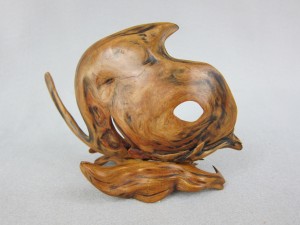The Art Within the Art
We have discussed the shapes of art to look for in each piece of wood you select. The oval, the Hogarth S-curve, interesting voids, triangles and circles, but now is the time to explore the elements that make our sculptures into art.
Unlike the woodcarver, we are not reproducing the shapes of nature in wood; driftwood sculptors are revealing the art of nature that is in the wood.
 Artistic success is the result of three factors: unity of design, compactness of form, and simplicity of outline.
Artistic success is the result of three factors: unity of design, compactness of form, and simplicity of outline.
Unity: Unity is the fundamental quality of all. A single unifying plan or design must bind all parts of the sculpture together as a whole. Extraneous angles or points which draw the eye away from the whole, or dissident chords that destroy your overall unity. Either keep your eye within the sculpture or make it soar, but do not see that section that draws your eye in two directions. Such distractions destroy the unity.
Compactness of Form: A pyramid, triangle, or cone convey their compactness of design. Look at our prize-winning sculptures to see those designs take place within that form. There is no distraction from the inner flow.
Simplicity of Design: We often say that mother nature gives us too much and we need to simplify our piece to achieve harmony within the sculpture. How pleasing to our eyes is the curl of a wave or just a single flame frozen in polished wood. Too much detail is often counter effective to a good sculpture. A heron in the reeds is lovely; a stork perched on a roof in a town is just too much.
Art is best expressed when styles repeat themselves within the sculpture. This tends to unify the piece. Do not remove anything early in your wood finishing. Sometimes, as you clean, scrape and sand, another shape or design emerges that ties a part you thought to remove back into the whole. Just keep the concept of the “art within the art” in the front of your mind while selecting and working on your wood.
